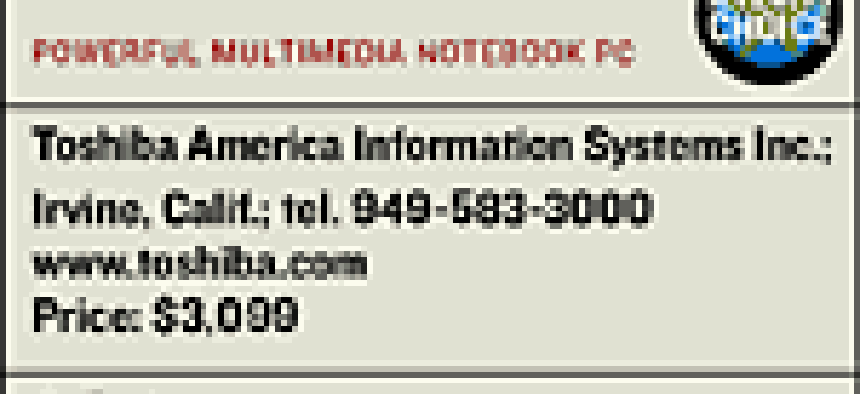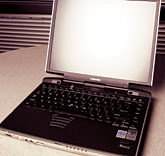The portable PC started out luggable'20 pounds or more'and took more than a decade to shrink to its present 5- to 7 pound weight. Because portables used many of the same components as desktop systems, their portability came at a cost in performance.Notebook PCs with components seemingly identical to those of desktop systems performed with less reliability and speed. Only a poorly designed desktop PC would have trouble dissipating heat, for example, whereas a cramped notebook case made overheating par for the course.Things are finally changing.The GCN Lab asked notebook makers to submit high-speed units running Microsoft Windows XP and rivaling desktop computers in every other way. Almost all the notebooks we received were more luggable than light'not that you couldn't tote them on a trip, but most weighed more than 6 pounds and had big screens.Such power units are often called desktop replacements because they take up far less room than a desktop PC and monitor while doing as much work. Yet they're portable when necessary.Regular readers of the lab's comparison reviews won't be surprised to hear that the was the fastest performer. It blazed through the lab's new benchmark suite from Alterion Corp. of Conshohocken, Pa., to score 3,573 points without breaking a sweat.For comparison purposes, it beat our baseline 1.1-GHz Celeron desktop system with 256M of RAM, which scored 3,365.The recently updated lab benchmark suite tests all aspects of processor performance, from raw number-crunching in Microsoft Excel and WinZip, to graphics in Specview Perf, to a mix of tasks under Adobe Photoshop.Because a processor works for about four hours to complete a benchmark test, notebooks with heat problems generally drop off in performance as they begin to stew.Dell's 1.13-GHz mobile Pentium III processor was a bit warm at the end of the Alterion tests, but not nearly as hot as other systems in the review.Another reason the Dell ran so fast was its 256M of 133-MHz synchronous dynamic RAM, expandable up to 512M with two free memory sockets.Aside from those components, the C810 was fairly standard. It had an impressive, 128-bit nVidia GeForce2 video chip set and a 4X Accelerated Graphics Port, and it showed its prowess by opening the massive Photoshop application in less than 10 seconds.The C810 earned an A grade and our Reviewer's Choice designation for consistently being a cut above the rest.We were surprised by the 8-pound sheer mass. At 13.3 by 11.3 by 1.7 inches, it was big, and it had something we haven't seen much lately from Gateway: great performance. The Solo snagged second place in the benchmark results with an average of 3,443 points.Its 1.06-GHz Pentium III processor with 256M of 733-MHz SDRAM outperformed some of the 1.2-GHz machines in the review, due in part to the 32M nVidia GeForce 2 chip set in the 4X Accelerated Graphics Port. Another reason for the Solo's impressive score was efficient heat management. With such a roomy case, hot air could exit and cool air could circulate more easily across the motherboard.The $2,069 price included a DVD/CD-rewritable combo drive and integrated wireless capability.The $2,600, 1.2-GHz had 256M of SDRAM and a 30G hard drive. Although there was no integrated wireless capability and only a low-end Radeon Mobility M6 PCI graphics card, the Lifebook E would be a good buy with its third-place benchmark score of 3,439 and compact size.Fujitsu paid a lot of attention to form factor. At 12.3 by 10.39 by 1.52 inches and 6.7 pounds, the Lifebook was the most portable unit in the review.The thin-film-transistor display was small at 14.1 inches, and there was no floppy drive, but the DVD/CD-RW combo drive'standard on most units in the review'would make it easy to get along without a floppy.We liked going on the road with the Lifebook. But it gets very hot in prolonged use.In fourth place, the took a big step up from last year's performance. With an average score of 3,226, it scored just 163 points less than the Sony Vaio'a barely noticeable difference.What was more noticeable was Micron's $2,130 price tag, $1,470 less than the Vaio's. Furthermore, the Micron had an integrated Orinoco wireless PC Card and a silicon-chip fingerprint reader. It was the only notebook in the review to incorporate a biometric security safeguard.The graphics card was the standard Mobility Radeon'decent considering the low price, as were the 256M of RAM, 20G hard drive and 14.1-inch TFT screen.If Micron improves the TransPort's display performance next year with a better graphics card, it could be a shoo-in for more than the Bang for the Buck designation it receives this time around.The sleekest notebook in the roundup was the 1-GHz With 256M of SDRAM and a 133-MHz bus transfer rate, the Vaio averaged a respectable 3,389 on the benchmarks. It hurtled past other big makers' products, but the Vaio had more than decent speed and good looks.A cylindrical wheel below the touchpad controlled a desktop navigator icon. When the wheel rolled up or down, the navigator icon flipped through folders and programs on screen. Pressing down on the wheel made a selection, and a Back button returned to the previous window.Once we got the hang of it, we found the navigator easier and more accurate than a standard touchpad. But the Sony also had a high price: $3,600. That included a 40G hard drive but not integrated wireless.The Vaio's Mobility Radeon graphics card with 16M of double-data-rate video SDRAM would be expected in a notebook at this level, but not at such a high price. The card delivered a decent 3-D performance but nothing like Dell's 128-bit nVidia GeForce 2.Sony had middle-of-the-road performance with some nice extras, at a high price.The IBM A30p featured lots of extras because IBM Corp. has been asking notebook users what they needed. But the A30p did not perform too well on the benchmarks, scoring 3,083'lower than the baseline Celeron system. A 1.2-GHz mobile Pentium III processor backed up by 512M of RAM should have performed better. Nevertheless, the extras helped make the A30p a true desktop replacement.One of the coolest extras was a hidden numeric keypad. Along the frame's right side was a button resembling a PC Card release mechanism that popped out the full-sized number pad. It felt like a natural keyboard extension and worked well in all tests.The IBM unit came with built-in IEEE 802.11b wireless networking, quite handy if your office has a wireless access point.Plus, IBM shored up one screen vulnerability that has crippled many notebooks long before the end of their expected lifetimes. IBM mounted the LCD with a standard plastic coupling, reinforced by two large metal bolts. The screen stayed put exactly where we raised it, without wobbling. And it did not look as if it would begin to slip under constant use.The Hewlett-Packard hit a downturn this year with a low test score of 2,881. Last year's OmniBook came in second in both benchmarks and overall.Despite sluggish test results, the OmniBook did well in several areas. The $2,700, 1.13-GHz unit had 256M of RAM running at 721 MHz, a 30G hard drive, an integrated wireless connection and a large 15-inch TFT screen. And the DVD/CD-RW combo drive weighed only 6.5 pounds.Last year's OmniBook cost about $1,000 more. Too bad the lower price this year brought lower quality.The WinBook Z1 was the slowest system, with a 1-GHz Pentium III processor and 256M of RAM. Even though it scored 2,426 on the Alterion benchmarks, its performance would rival that of most Pentium III desktop computers not in the gigahertz category. And the Z1 beat the other notebooks hands down in price. If you need a desktop replacement and have just $2,000 to spend, the Z1 is the only choice.XXXSPLITXXX-Forget HAL 9000. We'd much rather travel the galaxy with Toshiba's Tecra 9000.The Tecra notebook PC the GCN Lab tested was so powerful that our standard benchmarks from Alterion Corp. of Conshohocken, Pa., could not score its 3-D graphics performance properly.In a special test scaled back by Alterion to omit 3-D graphics, the Tecra 9000 scored better than any notebook ever tested in the lab, and nearly better than any desktop system.Our test unit had a 1.2-GHz mobile Pentium III processor, 256M of RAM, 512K of Level 2 cache and a 133-MHz front-side bus. At 5.3 pounds, it was lighter than any notebook in the accompanying review.The extra graphics power that swamped the Alterion benchmark came from a 64-bit S3 SuperSavage Mobile 3D graphics accelerator. Other machines had the usual ATI Rage Pro architecture. The Tecra blazed through 3-D graphics like a hot knife through butter.Sound was good from the stereo speakers mounted at either side of the case to rise up along with the 14.1-inch SXGA display. But I wished for more powerful speakers on a par with, say, the JBL speakers in the more ordinary Compaq Presario notebook.The Tecra had built-in Bluetooth and Cisco 802.11b Wi-Fi wireless connectivity, so it booted right onto the lab network. It also had a 56-Kbps V.90 modem and a 100Base-TX Ethernet port. A DVD-ROM/CD-rewritable drive supplied both read and write functions.Power users would have a difficult time finding an application that could stump the Tecra 9000. And the price, considering the power, was reasonable.An extra few hundred dollars more than the cost of the average notebook would be well worth it for users who need extra power on the road or in the office.
Eight portable units get up front and personal'with the speed, screen size and other features to push PCs out of the officeTime to redecorateDell Latitude C810Gateway Solo 9550'sFujitsu Lifebook E SeriesMicron TransPort GX2Fashion statementSony Vaio PCG-GR290.No silver this time OmniBook 6100GCN Lab technician Arthur Moser contributed to this review.Warp speed








